By U.S. Navy Seabee Museum, Naval History and Heritage Command
June 26
1945: ACORN 55 commissioned at Argus Assembly and Training Detachment (AATD) Port Hueneme, California. (Used during World War II, an ACORN was a tailored unit designed to carry out the rapid construction and subsequent operation of a landplane and seaplane advance base. Each ACORN had a construction battalion attached to it, as well as trained personnel to operate the control tower, field lighting, aerological unit, transportation, medical, berthing, and messing facilities. A Construction Battalion Maintenance Unit (CBMU) also accompanied each ACORN to maintain the base after the initial construction was completed and the construction battalion had been withdrawn. During the war, ACORNs were sent to such places at Guadalcanal, Espiritu Santo, Green Island, Rendova, Treasury Island, and Majuro.)
1963: A 280-foot hill at Naval Station Guantanamo Bay (GTMO), Cuba was dedicated and named Denich Hill in honor of George J. Denich, Jr., a 21-year old Seabee who was fatally injured in an accident while constructing fortified defensive positions on the hill, April 10, 1963. Denich, an Equipment Operator (Construction Equipment) 3rd Class in the U.S. Naval Reserve, served at GTMO with Mobile Construction Battalion (MCB) 7 during the 1962 Cuban missile crisis. He died in an accident while operating a mobile crane on the hill which now bears his name. During the dedication ceremony, his father, George J. Denich, Sr., unveiled a memorial plaque, which reads: Denich Hill . . . Dedicated to the memory of George J. Denich, Jr., who gave his life in the service of his country on 10 April 1963 while engaged in the construction of fortifications to protect his fellow Americans.
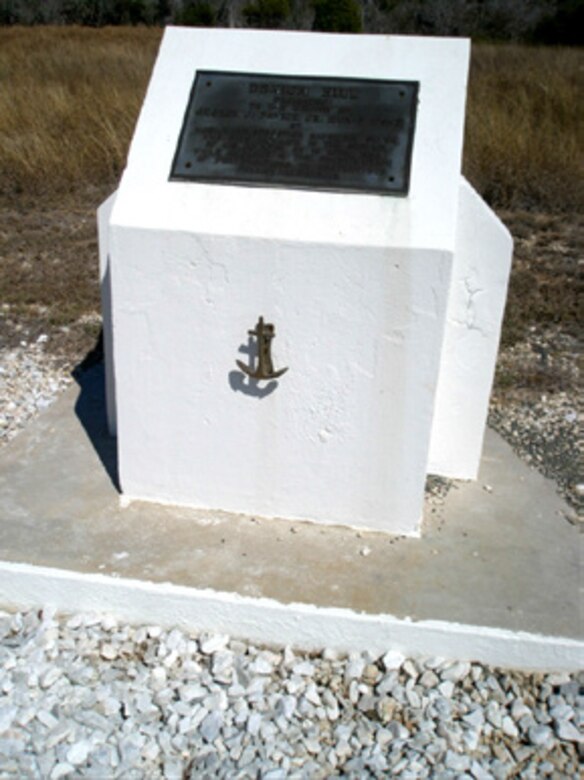
1967: Seabee Team 0809 departed for Port Hueneme, California for training and eventual deployment to the Republic of Vietnam (RVN).
1968: Naval Mobile Construction Battalion (NMCB) 71 relieved NMCB 40 at Camp Shields, Chu Lai, RVN.
June 27
1942: The Naval Construction Training Center (NCTC) Camp Endicott was established at Davisville, Rhode Island. It was named in honor of
Rear Adm. Mordecai T. Endicott, the first Civil Engineer Corps (CEC)officer to be appointed Chief of the Bureau of Yards and Docks. It was necessary to transfer personnel from the Naval Construction Training Center at Norfolk, Virginia to operate the station. Therefore, it wasn't untilAugust 12, 1942 before the first battalion started training at the camp. The capacity of the camp provided for ten battalions in training, totaling approximately 350 officers and 15,000 men. This capacity was reached early in November 1942. Both primary and advanced training were given at Camp Endicott. [caption id="attachment_16781" align="alignnone" width="618"]
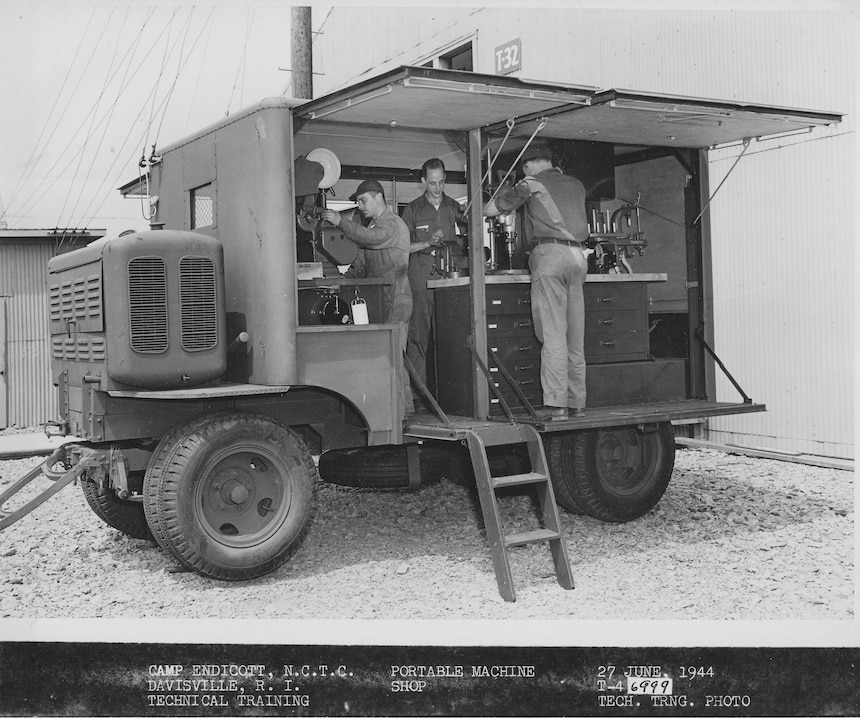
Portable Machine shop at NCTC Camp Endicott, Davisville, RI, 27 June 1944. (Courtesy of U.S. Navy Seabee Museum)
1958: Two members of NMCB 1, Teleman Albert H. Matthews, and Builder 2nd ClassRobert A. Wurst, were returning to Naval Station Guantanamo Bay from Guantanamo City, Cuba, when the report of a gun brought to a halt the civilian bus in which they were riding. Stopped by a jeep full of Fidel Castros soldiers, the bus driver, with his passengers including the two Seabees, was ordered to head up into the hills. When the bus could no longer make the steep mountain grades, its occupants were ordered to abandon it and proceed on foot. After walking most of the night they reached a small encampment. There they were given fruit and coffee. They were then loaded aboard a truck and carried deeper into the hills to another camp. Here the prisoners were not harmed, although living conditions were far from comfortable and consisted of eating mainly beans and rice. The release of the prisoners was subsequently obtained through negotiations with the rebel soldiers, and the two Seabees were picked up by a Navy helicopter and flown out of the hills.
1965: NMCB 9 on the USNS
Blatchford, arrived Da Nang Harbor, RVN. The battalion departed Port Hueneme June 3, 1965.
1968: Two officers and 24 enlisted men from Seabee Teams 0101 and 0102 deployed via one C-130 aircraft from Davisville, Rhode Islandto Saigon, RVN.
1969: NMCB 1 advance party arrived in Camp Campbell, Phu Bai, RVN.
1970: Seabee Teams 7104 and 7105 departed Davisville, Rhode Island for reassignment to Officer in Charge (OIC) Naval Construction Battalions, U.S. Pacific Fleet Detachment (CBPACDET), RVN and deployment to Soc Trang and Go Cong, RVN, respectively.
2006: Cmdr. Steve Hamer, Civil Engineer Corps (CEC),relieved Cmdr. John Korka, CEC,as commanding officer ofNMCB 4at Naval Base Ventura County, Port Hueneme, California.
2008: Cmdr. Stanley Wiles, CEC, assumed command of NMCB 1 from Cmdr. Dean Tufts as commander at Naval Construction Battalion Center (NCBC), Gulfport, Mississippi. [caption id="attachment_16777" align="alignnone" width="618"]
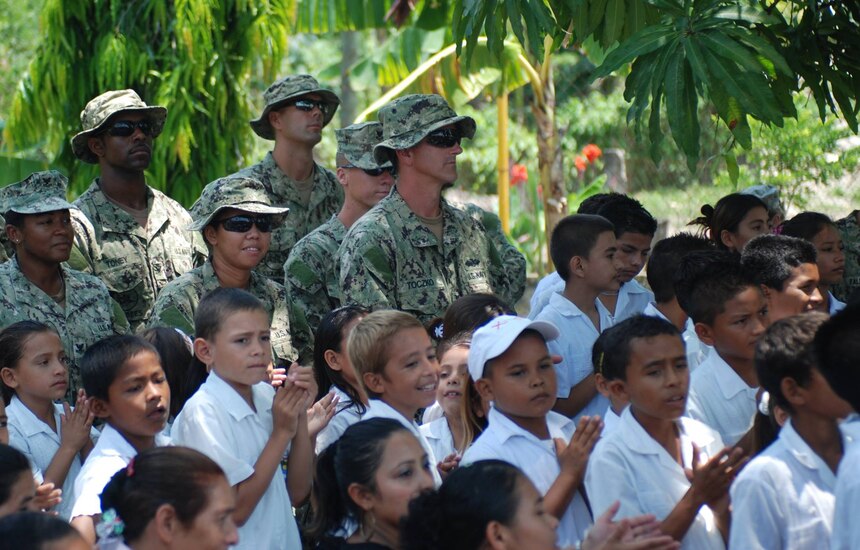 2012:
2012: Seabees from Naval Mobile Construction Battalion 23, based in Fort Belvoir, VA, watched the ribbon-cutting ceremony for a school they built in Morales, Honduras, with some of the students who would soon be attending classes there. The Fort Belvoir-based Seabees also completed a clinic in the town as part of U.S. Army South's Beyond the Horizon 2012 exercise. (Courtesy of U.S. Navy Seabee Museum)
June 28
1968: NMCB 7s advance party, consisting of eight officers and 108 enlisted men, arrived at the Dong Ha Combat Base, RVN, to perform the Battalion Equipment Evaluation Program (BEEP) and effect a smooth turnover of Camp Barnes from NMCB 5.
1968: Main body of NMCB 40 begins arriving at Davisville, Rhode Island from Chu Lai, RVN.
1969: Seabee Teams 0103 and 0104 arrived in RVN.
1969: NMCB 9s main body, consisting of 19 officers and 657 enlisted men, begins return to Naval Air Station Point Mugu, California, on two 707s, two Super DC-8s, and one C-141 cargo flight from Kadena Air Force Base, Okinawa, Japan.
2003: Joint Army, Navy and Marine engineers finished construction of a 762-foot floating steel bridge in Zubaydiyah, Iraq. Seabees from NMCB 7, NMCB 133, Naval Construction Support Team 2 from Port Hueneme, ACB 1, and ACB 2 worked with their Army and Marine partners to construct and emplace the bridge.
2006: Capt. Darius Banaji,CEC, relieved Capt. Bill Finn, CEC as commanding officer,NCTC, atNCBC Gulfport, Mississippi.
2011: Cmdr. Pete Maculan, CEC, relieved Cmdr. Scot Sanders, CEC, as commanding officer,NMCB 5 at Naval Base Ventura County, Port Hueneme, California.
2013: The Seabees of Naval Mobile Construction Battalion 133 marked a transition in the battalions history with a
change of command ceremony aboard Naval Construction Battalion Center Gulfport, June 28, 2013. During the ceremony, Cmdr. Nick Yamodis, CEC,relinquished command to Cmdr. Jeff Powell, CEC.
2016: Cmdr. Lance Flood, CEC, relieved Cmdr. Kemit Spears, CEC, as commanding officer of NMCB 1 during a
change of command ceremony aboard NCBC, Gulfport, Mississippi, June 28.
June 29
1906: Congress passed a law restricting the office of Chief of the Bureau of Yards and Docks to officers of the CEC.
1942: The 9th Naval Construction Battalion (NCB) wasestablished at NCTC Norfolk, Virginia.
2007: Rear Adm.Richard Cellon, CEC, relieved Rear Adm. Robert Phillips, CEC, as commander, 1st Naval Construction Division, Naval Amphibious Base Little Creek, Norfolk, Virginia.

This World War II-era advertisement showcased the Seabees' rhino ferry. It was a huge barge constructed from pontoons with two propelling units. In the first 10 days of the invasion of Normandy, 85 percent of all vehicular equipment was transported to shore using the rhino ferry. It was critical to defeating the Germans and proved to be a "bridge to victory," as the ad says. (Photo courtesy of the U.S. Navy Seabee Museum)
June 30
1943: American armed forces stormed ashore on Woodlark and Kiriwina Islands in the western Solomon Sea. Seabees of the 20th and 60th NCBs landed on Woodlark on D-Day. In the jungle, the Seabees hacked out a network of trails in order to dispense supplies unloaded on the beach. Soon they converted the trails to coral roads. On Woodlark, the Seabees also built a 6,500-foot airstrip. They then completed two more airstrips on Kiriwina. From these airfields, allied bombers swept north to bomb New Guinea and Rabaul.
1943: The 98th NCB was formed at NCTC Camp Peary, Magruder, Virginia.
1946: The 31st NCB was inactivated at Sasebo, Japan.
1967: NMCB 53 was recommissioned at Davisville, Rhode Island and assigned to the 21st Naval Construction Regiment (NCR).
1968: Seabee Team 0101 arrived in Saigon, RVN.
1969: Seabee Teams 0605 and 0606 were assigned to the 21st NCR for 18 weeks of specialized training.
1976: NMCB 10 was decommissioned. [caption id="attachment_16780" align="alignnone" width="783"]
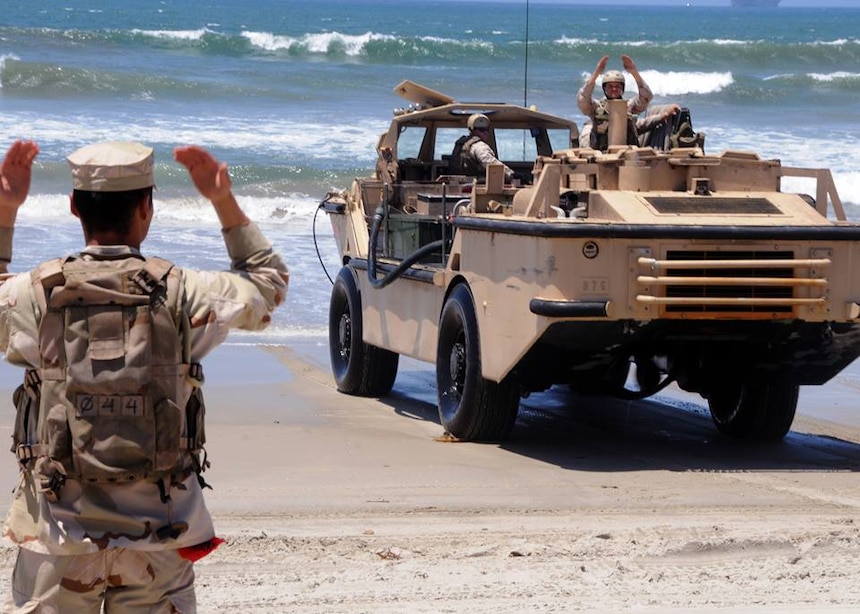 2008:
2008: Seabees assigned to Beach Master Unit (BMU) 1 guided a Lighter Amphibious Re-supply Cargo (LARC) from the surf at Red Beach Camp Pendleton, California during Joint Logistics Over-The-Shore (JLOTS) 2008. JLOTS 2008 established command and control of Army and Navy units, constructed a Life Support Area (LSA), conducted force protection operations, executed an in-stream offload of shipping from a sea echelon area, employed Offshore Petroleum Discharge System (OPDS), retrograde and safely redeploy allocated forces. (Courtesy of U.S. Navy Seabee Museum)
2010: Capt. John Korka, CEC, relieved Capt. James Worcester, CEC, as commander, 31st Seabee Readiness Group and Naval Facilities Expeditionary Logistics Center, Port Hueneme, California.
2016: Capt. Jeffrey Kilian, CEC,relieved Capt. James (Gordie) Meyer, CEC, as commander of the 3oth NCR during a
change of command ceremony in Port Hueneme, California.
2016: Lt. Cmdr. Benjamin Wainwright, CEC, was relieved by Lt. Cmdr. Joseph Dunaway, CEC, as commanding officer of Underwater Construction Team (UCT) 1.
July 1
1942: The 11th NCB was established at Camp Bradford, Little Creek, Virginia.
1943: ACORN 9 arrived at Noumea, New Caledonia; the 9th NCR commissioned; the 100th NCB commissioned at NCTC Camp Peary, Magruder, Virginia.
1967: Senior Chief Petty Officer Joseph R. Herrara of NMCB 11 was driving a truck near the Danang Air Base in the RVN. Before the day was out, he was involved in one of those thriller episodes. At 0640, a lone Viet Cong trooper shot a poisonous dart at the Chief. The dart shattered the wing glass of the truck and deeply gashed his arm. As soon as he realized he was under attack, he turned off the ignition and bailed out. Then as he ran toward the back of the truck, a rifle bullet hit his belt loop. To protect himself from the enemy hidden in a grove of trees, Chief Herrara withdrew his pistol and ran across the road to a ditch. When he saw the enemy trooper, he fired four rounds and then chased him. As the Chief approached a sand mound, the enemy soldier hurled a hand grenade and the Chief, seeing an object flying through the air, dropped to the ground. The grenade landed about 30 feet from him. However, after a short wait, the grenade failed to explode. Chief Herrara rose and slowly approached the grenade. As he examined it, he noticed that the pin was still partially inserted and thus, it was prevented from detonating. Rather than press his luck further, he returned to his truck and signaled nearby Marines for help.
1968: Seabee Team 5801 arrived in Davisville, Rhode Island from RVN for reassignment to NMCB 58.
1969: Seabee Team 0411 moved from NCBC, Port Hueneme, California to Thailand where they began their deployment.
1969: Seabee Teams 0103 and 0104 deployed to RVN for duty at My Tho and Xuan Loc.
1972: The brig at NCBC, Port Hueneme, California closed its doors after 26 years of almost uninterrupted operation dating back to the end of World War II. During the war years, there were 11 brigs in the area. Not so many when you consider that the military population was over 27,000 at the time. With the reduction of operations and personnel at the wars end, correctional facilities were reduced to one building. Operation of the brig was continuous from 1946, except for a brief 10-month hiatus from October 1949 until August 1950 when the brig was temporarily closed for economic reasons. The brig or correctional center, as it was officially called from 1969 until it closed, was closed because of the low prisoner population.
2015: Lt. Cmdr. Samuel Werschky was relieved by Lt. Cmdr. Elizabeth Durika of Construction Battalion Maintenance Unit (CBMU) 202 during a change of command ceremony at Joint Expeditionary Base Little Creek-Fort Story, Virginia.
2016: Capt. Michael Saum, CEC, relieved Capt. Christopher Kurgan, CEC, as commander, Naval Construction Group 1, during a change of command ceremony at Naval Base Ventura County, Port Hueneme, California.
July 2
[caption id="attachment_16824" align="alignnone" width="505"]
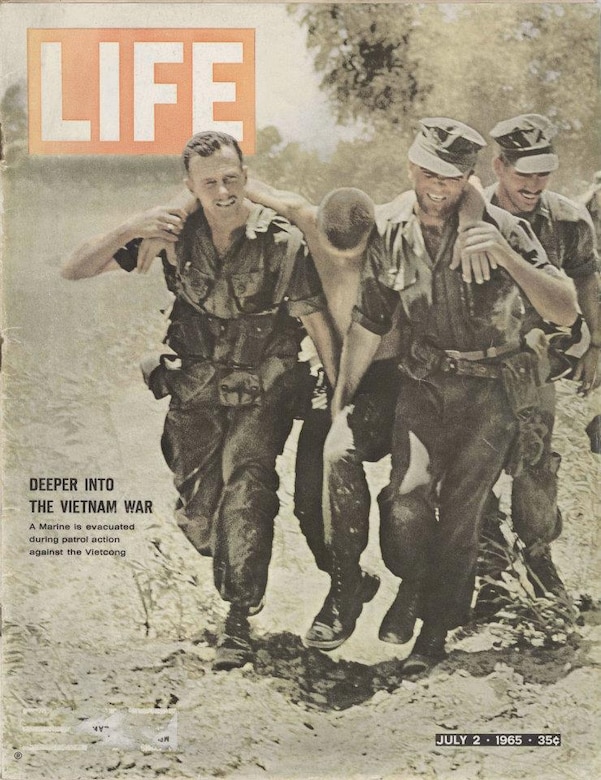
LIFE magazine July 2, 1965. Chief Johnny McCully, AIC of Seabee TEam 1104, is being assisted to a waiting helicopter. (Courtesy of U.S. Navy Seabee Museum)
1943: Lt. j.g.George Stephenson, CEC,and Lt. Irwin Lee, CEC,of the 24th NCB, were killed on Rendova in the Solomons, the first CEC officers to be killed in action in World War II.
1944: Less than a month after D-Day in France, while the Normandy invasion was still underway, the 81st NCB experienced one of those odd happenings of war on which legends are built. Early on the morning of July 2,Lt. Cmdr.Richard Anderson, Seabee medical officer for the recently-landed battalion, was visited in his foxhole by a breathless American military policeman. A woman in the nearby village of Sainte-Marie-du-Mont was about to have a baby and a doctor was urgently needed. Anderson immediately dispatched his assistant medical officer, Lt. Douglas Butman. Butman arrived at the house only to discover that the young woman had spontaneously delivered her child, a little girl, only moments before. The doctor immediately rendered the appropriate postnatal care. In the days that followed, the medical staff of the battalion paid many visits to the home of Henri and Marie Fouchard. Finally, the time came for christening the baby girl. The mother asked Commander Anderson if the baby could bear a part of his wifes name. Anderson delightedly suggested the initials of his wifes maiden name, C.B., for he knew that such a choice would serve a two-fold purpose. The initials would honor his wife and also would honor the battalion as Sea Bee. Thus, Sea Bee Paule Fouchard was christened in honor of an informal battalion of godfathers who had attended her birth at the height of fighting in Normandy.
1966: NMCB 62 was commissioned and was the first battalion assigned to the NCBC, Gulfport, Mississippi, after the Centers mission was increased to provide home base facilities for naval construction battalions.
1969: Seabee Team 0913 returned to NAS Point Mugu, California on a DC-8 aircraft from Da Nang, RVN.